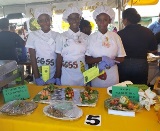School Food

As of 2022, Guyana has three separate school meal programmes that are operated and funded by the Ministry of Education. These programmes differ in the types of food offered, targeted percentage of recommended dietary allowances, geographic distribution, and practices for procurement and monitoring and evaluation. They include: the community-based hot meals programme; the breakfast programme; and the fortified biscuit and juice snack programme (a fourth, the peanut butter and cassava bread snack programme, is not currently operational). There is also a pilot home-grown school feeding programme supported by FAO.
The main characteristics of these programmes are summarized below:
School meal programme | Target group | Type of meal offered |
Community-based hot meals programme (since 2006)
| Pre-primary and primary schools from the hinterlands regions 1, 2 (riverain), 7, 8 and 9
| Hot cooked lunches
|
Breakfast programme (since 2017) | Currently restricted to grade 6 students in six regions, following re-launch in 2022 after COVID-19 [the programme was previously targeted at nursery and primary schools, (grades 1-2) in the country’s three coastal communities]
| Breakfast consists of a sandwich with different fillings (eggs, cheese, peanut butter or tuna) and a milk-based drink, served daily between 8-8:30 am. On Friday, a locally produced rice-based cereal is served with a milk-based drink.
|
Fortified biscuit and juice snack programme (since 2010) | Nursery and primary schools in grades 1- 2 in eight regions | Six fortified biscuits and one box of juice daily during the timetabled morning break |
Most schools also have privately operated canteens and/or food vendors and a significant number of children bring lunch from home. There are currently no official nutrition guidelines and standards in place for school food in Guyana, in part due to the absence of data on the nutritional status of students.
Menus for the community-based hot meals are currently decided by the School Feeding Management Committees in each school since dietary preferences differ between regions. However, the Ministry of Education with support from the Carnegie School of Home Economics based in Guyana have developed a four-week menu cycle to guide the planning of meals for the Home-grown School Feeding pilot, based on the country’s Food Based Dietary Guidelines. The Carnegie School is developing a similar list of recipes for the hot meal and breakfast programmes, which is awaiting final approval and is expected to be implemented in 2023.
The Ministry of Education conducts annual training, based on the Guyana Food Based Dietary Guidelines, for caterers and kitchen staff involved in providing meals for the hot meals programme. However, there is currently no specific monitoring on whether these guidelines are being followed and menus for each school are decided by its own school food management committee.
The Ministry of Public Health supported the development of school canteen standards to ensure the safety and quality of school meals and they are responsible for sending public health inspectors to ensure that school kitchens and school meals comply. Regular monitoring and evaluation progress reports are prepared on a monthly basis, but these do not cover the nutritional quality of the meals.
As of 2022, a national school food policy is being developed by the Ministry of Education in conjunction with the University of Guyana and in consultation with the Ministries of Health and Agriculture, the Carnegie School of Home Economics, FAO and WFP. The new policy will cover regulations on types of foods that can be sold and prepared in and around schools by food vendors, canteens and tuck shops.
Relevant Links
- FAO in Guyana
- The Right to food Guyana
- Global Child Nutrition Foundation (GCNF): School meal programme profile (2021)
Videos
Articles

World Food Day 2019: Schools Healthy Meals Challenge (Guyana)
21/10/2019
Healthy Diets for a Zero Hunger world was indeed the obvious mantra when looking at and sampling the delicious meals prepared by secondary students from ten different schools across Guyana. World Food Day 2019 celebrated on October 16, brought together not only agencies of the Ministry of Agriculture but also students, parents and teachers representing the four Regions of Guyana.

School Feeding Programmes in Guyana creating opportunities for Female Farmers
27/03/2022
The school feeding programme in Guyana dates as far back as forty (40) years ago and continues to positively impact the nutrition and health of children and adolescents receiving nursery, primary or secondary education which represents some 48.6% of the total student population in the country.
